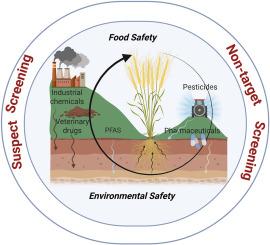农业相关有机污染物可疑与非目标筛选研究进展
IF 6
2区 化学
Q1 CHEMISTRY, ANALYTICAL
引用次数: 0
摘要
旨在减少浪费和促进材料再利用的生产系统有助于实现更可持续的粮食系统。然而,这些方法也可能导致从有机废物到土壤并最终到食物的化学危害的积累和再循环。为了解决这些风险并评估农业废物再利用的安全性和有效性,非目标筛选(NTS)和可疑筛选(SS)分析方法至关重要,因为它们能够检测土壤、作物和堆肥中的化学残留物、污染物和意外副产品。结果对2021-2025年期间的文献进行了综述,以确定最近的分析进展以及SS和NTS策略在粮食生产系统中的应用。该综述强调了与传统目标分析相关的关键分析挑战,并探讨了SS和NTS方法所取得的改进。重点放在样品处理(提取和清理),仪器,数据处理和分析工具的进步。此外,该综述还概述了在农业食品系统中使用SS和NTS方法确定的化学品危害。该综述强调了在识别已知和未知危险化学品的SS和NTS战略的发展方面取得的重大进展。然而,它也揭示了在可持续农业框架内具体应用这些方法的研究数量有限。尽管存在这一差距,SS和NTS在支持农业食品系统中更安全和更可持续实践方面的潜力表明,它们在未来研究中的广泛应用可能会引起科学界的极大兴趣。本文章由计算机程序翻译,如有差异,请以英文原文为准。

A review of Suspect and Non-target Screening of Agriculture-Related Organic Contaminants
Background
Production systems that aim to reduce waste and promote the reuse of materials contribute to more sustainable food systems. However, these approaches can also lead to the accumulation and recirculation of chemical hazards from organic waste to the soil and, ultimately, to food. To address these risks and assess the safety and effectiveness of waste reuse in agriculture, non-target screening (NTS) and suspect screening (SS) analytical methodologies are essential, as they enable the detection of chemical residues, pollutants, and unintended by-products in soil, crops, and compost.Results
A literature review covering the period 2021–2025 was conducted to identify recent analytical advances and the application of SS and NTS strategies in food production systems. The review highlights key analytical challenges associated with traditional targeted analysis and explores the improvements achieved by SS and NTS approaches. Emphasis is placed on advancements in sample treatment (extraction and clean-up), instrumentation , and data processing and analysis tools. Furthermore, the review provides an overview of chemical hazards identified using SS and NTS methodologies within the context of agri-food systems.Significance
The review highlights significant progress in the development of SS and NTS strategies for the identification of known and unknown hazardous chemicals. However, it also reveals a limited number of studies applying these approaches specifically within sustainable agriculture frameworks. Despite this gap, the potential of SS and NTS to support safer and more sustainable practices in agri-food systems suggests that their broader application could be of considerable interest to the scientific community in future research.求助全文
通过发布文献求助,成功后即可免费获取论文全文。
去求助
来源期刊

Analytica Chimica Acta
化学-分析化学
CiteScore
10.40
自引率
6.50%
发文量
1081
审稿时长
38 days
期刊介绍:
Analytica Chimica Acta has an open access mirror journal Analytica Chimica Acta: X, sharing the same aims and scope, editorial team, submission system and rigorous peer review.
Analytica Chimica Acta provides a forum for the rapid publication of original research, and critical, comprehensive reviews dealing with all aspects of fundamental and applied modern analytical chemistry. The journal welcomes the submission of research papers which report studies concerning the development of new and significant analytical methodologies. In determining the suitability of submitted articles for publication, particular scrutiny will be placed on the degree of novelty and impact of the research and the extent to which it adds to the existing body of knowledge in analytical chemistry.
 求助内容:
求助内容: 应助结果提醒方式:
应助结果提醒方式:


